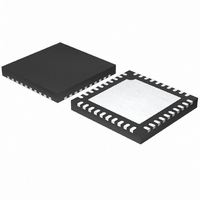MAX15035ETL+ Maxim Integrated Products, MAX15035ETL+ Datasheet - Page 20

MAX15035ETL+
Manufacturer Part Number
MAX15035ETL+
Description
IC REG STEP DOWN 15A 40-TQFN
Manufacturer
Maxim Integrated Products
Type
Step-Down (Buck)r
Datasheet
1.MAX15035ETL.pdf
(26 pages)
Specifications of MAX15035ETL+
Internal Switch(s)
Yes
Synchronous Rectifier
Yes
Number Of Outputs
1
Voltage - Output
1.05V, 1.5V
Current - Output
15A
Voltage - Input
4.5 ~ 26 V
Operating Temperature
-40°C ~ 85°C
Mounting Type
Surface Mount
Package / Case
40-TQFN Exposed Pad
Power - Output
2.16W
Lead Free Status / RoHS Status
Lead free / RoHS Compliant
Frequency - Switching
-
Lead Free Status / Rohs Status
Lead free / RoHS Compliant
15A Step-Down Regulator with Internal Switches
•
The switching frequency and operating point (% ripple
current or LIR) determine the inductor value as follows:
Find a low-loss inductor having the lowest possible DC
resistance that fits in the allotted dimensions. Ferrite
cores are often the best choice, although powdered
iron is inexpensive and can work well at 200kHz. The
core must be large enough not to saturate at the peak
inductor current (I
The inductor ripple current impacts transient-response
performance, especially at low V
Low inductor values allow the inductor current to slew
faster, replenishing charge removed from the output fil-
ter capacitors by a sudden load step. The amount of
output sag is also a function of the maximum duty factor,
which can be calculated from the on-time and minimum
off-time. The worst-case output sag voltage can be
determined by:
where t
Characteristics table).
20
V
SAG
Inductor operating point: This choice provides
trade-offs between size vs. efficiency and transient
response vs. output noise. Low inductor values pro-
vide better transient response and smaller physical
size, but also result in lower efficiency and higher
output noise due to increased ripple current. The
minimum practical inductor value is one that causes
the circuit to operate at the edge of critical conduc-
tion (where the inductor current just touches zero
with every cycle at maximum load). Inductor values
lower than this grant no further size-reduction bene-
fit. The optimum operating point is usually found
between 20% and 50% ripple current.
______________________________________________________________________________________
OFF(MIN)
=
2
L
C
L
(
OUT OUT
Δ
=
I
LOAD(MAX)
I
⎛
⎜
⎝
PEAK
is the minimum off-time (see the Electrical
V
f
SW LOAD MAX
PEAK
I
V
IN
=
⎡
⎢
⎢
⎣
):
⎛
⎜ ⎜
⎝
I
LOAD MAX
−
(
V
)
V
(
2
IN
OUT
−
⎡
⎢
⎣
(
⎛
⎜
⎝
Transient Response
V
V
V
)
OUT SW
LIR
OUT SW
IN
Inductor Selection
IN
V
)
IN
⎞
⎟
⎠
+
)
t
⎛
⎜
⎝
- V
t
Δ
V
2
I
OUT
V
L
OUT
IN
⎞
⎟ +
⎠
⎞
⎟
⎟ ⎟ −
⎠
t
OFF
⎞
⎟
⎠
t
OFF MIN
differentials.
(M M IN
(
)
⎤
⎥
⎦
)
⎤
⎥
⎥
⎦
The amount of overshoot due to stored inductor energy
when the load is removed can be calculated as:
The minimum current-limit threshold must be high
enough to support the maximum load current when the
current limit is at the minimum tolerance value. The val-
ley of the inductor current occurs at I
half the inductor ripple current (ΔI
where I
threshold voltage divided by 0.006.
The valley current-limit threshold is precisely 1/20 the
voltage seen at ILIM. Connect a resistive divider from
REF to ILIM to analog ground (GND) to set a fixed valley
current-limit threshold. The external 400mV to 2V adjust-
ment range corresponds to a 20mV to 100mV valley cur-
rent-limit threshold. When adjusting the current-limit
threshold, use 1% tolerance resistors and a divider cur-
rent of approximately 5μA to 10μA to prevent significant
inaccuracy in the valley current-limit tolerance.
The MAX15035 uses the low-side MOSFET’s on-resis-
tance as the current-sense element (R
R
tional resistance for each degree celsius of tempera-
ture rise, which must be included in the design margin
unless the design includes an NTC thermistor in the
ILIM resistive voltage-divider to thermally compensate
the current-limit threshold.
Including an additional resistor between ILIM and the
output automatically creates a current-limit threshold that
folds back as the output voltage drops (see Figure 8).
The foldback current limit helps limit the inductor cur-
rent under fault conditions, but must be carefully
designed to provide reliable performance under normal
conditions. The current-limit threshold must not be set
too low, or the controller will not reliably power up. To
ensure the controller powers up properly, the minimum
current-limit threshold (when V
be greater than the maximum load during startup
(which at least consists of leakage currents), plus the
maximum current required to charge the output capaci-
tors:
DS(ON)
I
LIMIT(LOW)
START
). A good general rule is to allow 0.5% addi-
I
LIMIT LOW
Setting the Valley Current Limit
= C
V
SOAR
(
OUT
equals the minimum current-limit
≈
x 1mV/μs + I
)
(
>
Δ
I
I
2
LOAD MAX
LOAD MAX
C
OUT OUT
Foldback Current Limit
OUT
(
(
V
L
); therefore:
LOAD(START)
= 0V) must always
)
)
)
−
LOAD(MAX)
2
L
Δ
2
I
L
SENSE
minus
=












